

Mexican Astrophysicist Leticia Corral Recognized for ‘Cyclical Universe’ Discovery Which Corrects Stephen Hawking’s Mistake
A Latin American astrophysicist has debunked Stephen Hawking’s assertions about the origin of the universe.
Mexican cosmologist Leticia Corral has been recognized for her career-defining theory about how the universe came into existence. Contrary to what the world-renowned astrophysicist has been advocating over the years, Corral believes the universe is cyclical…
Link to article
The Perceptions, Knowledge , Benefits and Barriers of Hispanics Regarding the Dietary Guidelines for Americans
LDA Gamboa – 2015
… 2005). However, the San Antonio Heart Study contradicted this paradox, showing
that Mexican- Americans indeed had a higher risk of cardiovascular and coronary
diseases than did non-Hispanic Whites (Hunt et al., 2003). …
Link to thesis
Digging for a Tale: Genomic Analysis Solves Mysteries Surrounding America’s Earliest People
T Tanenbaum
… and her colleagues undertook genetics as well as morphological analyses on historical Mexican
and South American populations, the latter to re-evaluate whether these ancient skulls were closer
in skull morphology to Australo-Melanesians than to modern Native Americans. …
Link to article
John G. Florez Chemical engineering has taken this ACS Scholar around the world to encourage others to take up STEM education
A Scott – 2015
… An additional role he has taken on during his years at ExxonMobil has been to encourage other
Mexican Americans to establish a scientific career. … Mexican Americans continue to be poorly
represented in STEM subjects at the university level, Florez says. ..
Link to article
From the Delano Grape Strike to the Mexican American Vintners Association
By Humberto Gutierrez
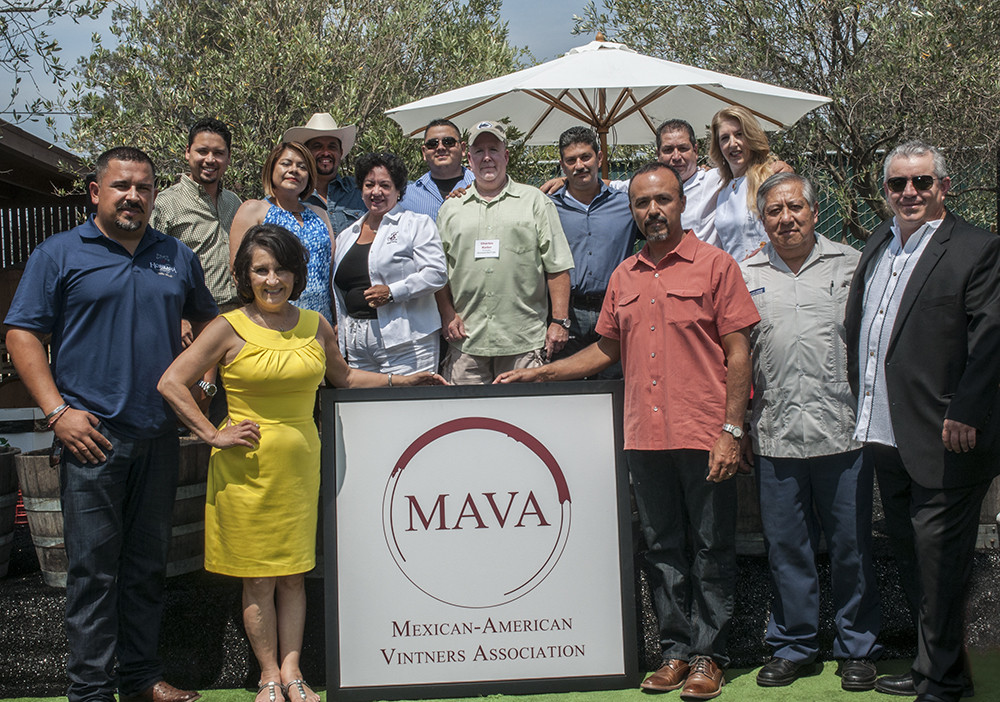
There have been several longitudinal studies on Mexican American mobility showing that although the monetary movement of Mexican Americans is not quite as rapid as that of whites, there is still a steady accumulation of wealth across generations.
This mobility is evidenced by the progress made by Mexican American professionals. As evidence of this success, we have witnessed the birth of several prominent professional associations. Most notable are:
- MAES, Latinos in Science and Engineering
- AMAE, Association of Mexican American Educators
- MABA, Mexican American Bar Association
- SACNAS, Society for Advancement of Chicanos and Native Americans in Science
- MAHPA, Mexican American Hispanic Physicians Association
- MABPA, Mexican American Business and Professional Association
- MALFA, Mexican American Latino Faculty Association
- MAVA, Mexican American Vintners Association
The latest American Community Survey shows year-to-year progress, or lack of it, on the survey’s annual census.
Prominent among this year is the continued progress of Mexican American college enrollment, which has jumped from 18.1% in 2013 to 18.7% in 2014. Unfortunately, graduate or professional degrees remain low with a small gain. For 2013, the graduate or professional degree was 11.2% and for 2014 this percentage climbed to 11.4% for the total population, while for 2013 it was 2.8% for Mexican Americans, and 2.9% for 2014.

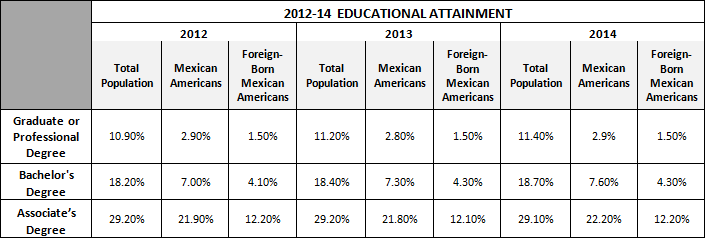
Occupations in management, business, science, and arts showed a nice increase for Mexican Americans, from 16.7% to 17.4% while for the total population percentages went from 36.3% in 2013 to 36.9% in 2014. Mexican Americans still lag far behind the total population but there is a slight gain as compared to the total population.

For industry, numbers have gone up slightly for the total population but have remained stagnant for Mexican Americans.
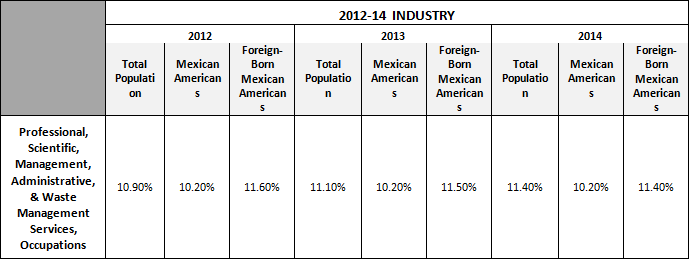
References
- Census Bureau, Selected Population Profile in the United States: 2014
- United States S0201 and B05006. Selected Population Profile in the United States
- Population Groups: Mexican and Mexico (foreign-born)
- Data Set: American Community Survey 1-Year Estimates for years 2012 and 2014
- Census Bureau, American Fact Finder, Selected Population Profile in the United States
Science: There Is No Such Thing As Race
Back in 1950, an international panel of geneticists, sociologists, anthropologists, and psychologists issued a statement through the United Nations Educational, Scientific and Cultural Organization (UNESCO) affirming that all humans belong to the same species. sapiens.
Back in 1950, an international panel of geneticists, sociologists, anthropologists, and psychologists issued a statement through the United Nations Educational, Scientific and Cultural Organization (UNESCO) affirming that all humans belong to the same species…Race is not a biological reality. It is an adaptation of humans living in different parts of the world – and society’s way of dividing people up.
What is referred to as “race” is in actuality a product of social context – as there is only one biological race in the human species: Homo sapiens…
Link to article
Looking to hire Hispanic STEM graduates? FIU a top producer of science and engineering talent
FIU graduates more Hispanics with bachelor’s and master’s degrees in science, technology, engineering and math (STEM) than any other university in the continental U.S., according to a report released today by Excelencia in Education.
Finding Your Workforce: Latinos in Science, Technology, Engineering, and Math (STEM), identifies institutions that graduate large numbers of Hispanics with STEM degrees in hopes of encouraging employers to engage with these institutions and hire graduates. FIU ranked second only to universities in Puerto Rico in graduating Hispanics with bachelor’s and master’s degrees…
Link to article
Interactive effects of acculturation and pro-inflammatory factors on C-reactive protein among childbearing age Mexican-American women in the United States
Maternal pro-inflammatory states have been linked with increased risk of diabetes and obesity in offspring. Childbearing-age Mexican-American women (CAMAW) have the highest fertility rates and one of the highest levels of inflammation in the United States. A significant proportion migrates to the U.S. during early reproductive years. How acculturation interacts with various pro-inflammatory risk factors to influence inflammation risk in this population has not been examined…
Link to abstract
Beyond immigrant status: Book-sharing in low-income Mexican-American families
M Salinas, DR Pérez-Granados, HM Feldman… – Journal of Early Childhood …, 2015
… Rank) Score: 0.726 | 47/222 Health (Social Science) | 125/273 Developmental and
Educational Psychology | 204/1035 Education (Scopus®). Beyond immigrant status:
Book-sharing in low-income Mexican-American families. …
Link to abstract
SF State awarded $17 million by NIH to enhance workforce diversity in biomedical research
SAN FRANCISCO, Oct. 22, 2014 — San Francisco State University has been awarded $17.04 million to address issues of workforce diversity in biomedical research, the National Institutes of Health announced today.
The effort is called SF BUILD, which stands for Building Infrastructure Leading to Diversity. Professors in biology, chemistry/biochemistry, psychology, geography & environment, and other fields at SF State working on the project are seeking to upend the presuppositions about members of minority communities — that they may not have the aptitude or the background to excel in the sciences. “We are funded to prime institutional transformation,” said Professor of Biology Leticia Márquez-Magaña, the principal investigator for SF BUILD. “Let’s fix the institution, instead of fixing the students and not recognizing their assets.”…
Link to article
Finalists revealed: VL Innovators Challenge
Latinos use digital media more than any other ethnic group. But few Latinos are translating their tech savvy into tech work. In fact, only 7% of technology workers are Hispanic. Voto Latino believes Latinos can use their tech savviness to open doors to amazing careers in Science, Engineering, Technology and Math (STEM).
The VL Innovators Challenge was created to get millennials, especially Latino millennials, thinking about technology both as an innovative change agent and as a potential career. Applicants were encouraged to “use a tech tool to address a need in the Latino community.”
The Challenge will award $500,000 in grants to the best proposed projects. Winners will also spend two days on the Google campus in California where they will be paired with members of Google’s Marketing, Creative Labs, and Android teams, among others. Besides the chance…
Link to article
Mexican American Children and Families: Multidisciplinary Perspectives
MOB Caughy, L Franzini – Mexican American Children and Families: …, 2014
… Policy makers and public health professionals must recognize the heterogeneity within and among …
Selected measures of health status for Mexican-American, mainland Puerto Rican, and Cuban …
Child Maltreatment: Journal of the American Professional Society on the Abuse of …
Link to preview of book
Tech Program Helps Put Latinos On A Path To Silicon Valley
About an hour south of Silicon Valley in a classroom at Hartnell Community College, Daniel Diaz and Brian De Anda stand at a whiteboard mapping out ideas on how to reduce the size of a mobile app their team is building.
This isn’t a class, and the app they’re building — an informational guide for a drug rehab center — isn’t even a school project. But this is what it takes to have a chance at an elite summer internship, says Daniel Diaz.
“What you are taught at school is not enough,” Diaz says, “especially in today’s competitive society. I think you need to do some more outside learning.”The inaugural class of the Computer Science and Information Technology program, scheduled to graduate in 2016.All Tech ConsideredOut Of The Fields And Into Computer Science Classes
So these students are working on other apps, doing hackathons and learning additional programming languages outside of class. They’re doing it because there’s a thought — perhaps a reality — that hangs over…
Link to article
In 3 Minutes, This Video Will Completely Change the Way You Think About Race
By Marcie Bianco January 14, 2015
Is “race” just another label?
From Raven-Symoné to Toni Morrison, a growing number of people are now claiming that race is a social construct. As Morrison told Stephen Colbert last year, “There’s no such thing as race. None. There’s just the human race, scientifically, anthropologically. Racism [too] is a construct.” Not that race isn’t without benefits, she explained: “Money can be made off of it. People who don’t like themselves can feel better because of it. … It has a social function.”
But what does that actually mean? Jenée Desmond Harris, in a new video for Vox, has created an excellent primer for anyone confused about the concept. Whether you agree with her or not, this three-minute video will almost certainly get you thinking differently about race…
Link to article
Lessons to be learned from Latinos with dream jobs in tech
For millennials, jobs in the highest reaches of tech are among the most coveted. For Latino millennials, they sometimes seem unobtainable.
The numbers don’t lie. At Google, Twitter, and Facebook, Latino employees make up between 2 percent and 3 percent of their respective workforce. These abysmal numbers are standard also throughout Silicon Valley, where overall only 3 percent of workers are Latino…
Link to article
Slow and Steady Progress for Mexican American Professionals: The results of the American surveys for the years 2010-2012 show positive results
By Humberto Gutierrez
Edited by Kristen House
College enrollment showed an increase of 1.4 percent from 2010 to 2012—a positive sign for Mexican Americans wanting to achieve higher academic and professional goals. Here is the data.

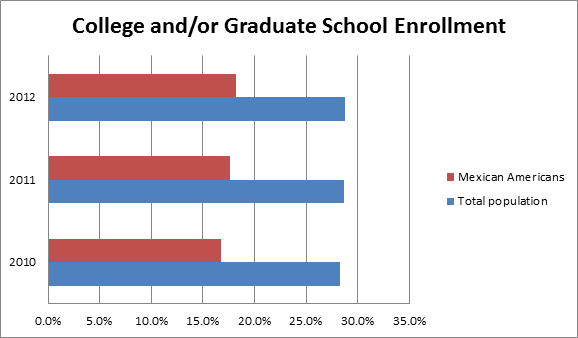
Educational attainment shows no change to the terrible numbers of 2.6 percent for the years 2010 and 2011 but there is hope in that 2012 showed a small gain to 2.9 percent.

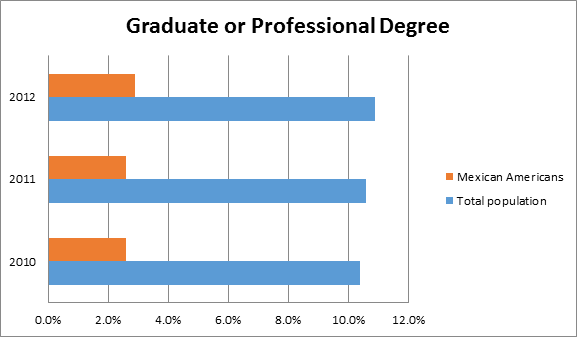
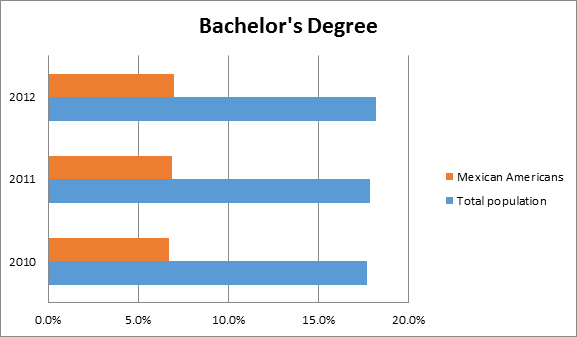
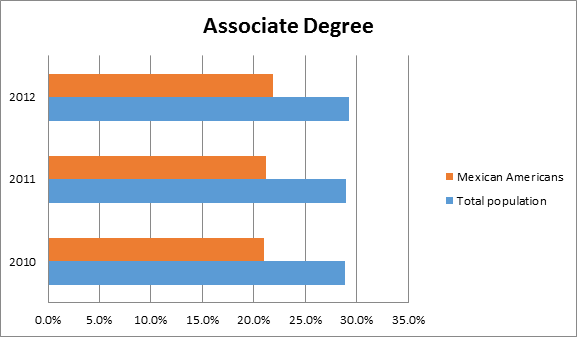
For occupations, there was a .2 percent increment yearly, but still shows that in management, business, science, and art occupations, there is still a wide gap between the total population at 36.1 percent for the year 2012 and 16.6 percent for Mexican Americans.

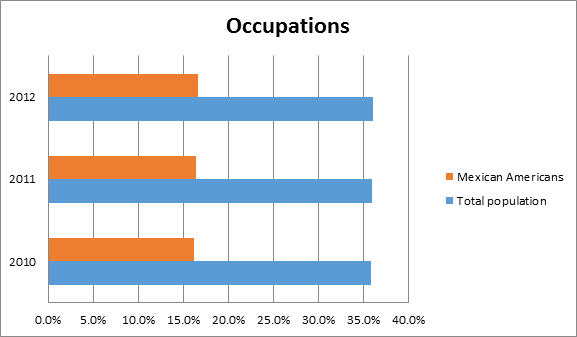
For professional, scientific, and management and administrative and waste management services, there is a close correlation between the percentage represented by the total population and Mexican Americans.

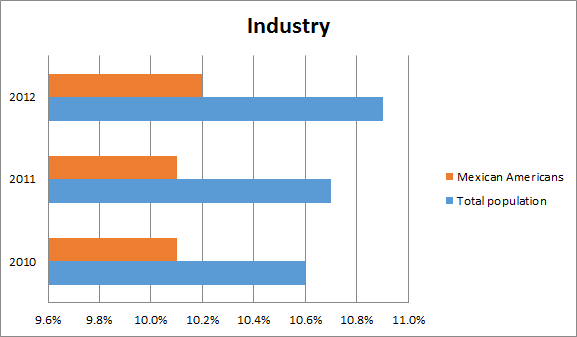
Summary:
There is hope at the end of the tunnel. College and university enrollment has been trending higher for Mexican Americans. Unfortunately, the percentage of students with graduate degrees stayed the same for the years 2010 and 2011, but rose a small amount in 2012. Percentages showing students with BA and AA degrees trended higher—an encouraging sign. Occupations still showed a wide margin between the total population and Mexican Americans. The Mexican American population showed a small increase in professional, scientific, and management and administrative and waste management employment while the total population showed a small but steady increase in this area.
References:
- Census Bureau, Selected Population Profile in the United States: 2010 – 2012
- United States S0201. Selected population Profile in the United States
- Population Group: Mexican and Total Population
- Data Set: American Community Survey 1-Year Estimates
What It’s Like to Be a Latino Entrepreneur in Silicon Valley
November 24, 2014 SAN JOSE, Caif.—Alex Murillo leans forward in his seat, sipping coffee from a shot glass and waving his hands as he talks. He points to the screen of his MacBook Pro, explaining the genius behind Audive, the mobile application he is developing that allows users to record cover songs and mix tracks with music enthusiasts around the world.
“This is the secret sauce,” says Murillo, hitting a key on his computer that fills the air with the sound of a man singing in Italian. “You can bring in vocals from a guy in Italy or you can bring in the flamenco guitar from Spain.”
Murillo has made this pitch about three times to potential investors in Silicon Valley since launching his start-up this summer. He came up with the idea and polished his pitch with the help of Manos Accelerator, a…
Link to article
Hopeful Gains in Higher Education for Mexican Americans
By Humberto Gutierrez
Edited by Kristen House
The latest figures from the 2013 American Community Survey show progress in the wide gap between the total US professional population and Mexican Americans:
- 2012 college and/or graduate enrollment was 28.8% for the total population but only 18.2% for Mexican Americans.
- 2013 college and/or graduate enrollment was 28.3% for the total population, 18.1% for Mexican Americans, and 33.3% for foreign-born Mexican Americans.
College enrollment for the total population has decreased from the years 2012 to 2013 by 463,000 according the Census Bureau as stated in their Sept. 24, 2014 press release.
For Mexican Americans, there was also an enrollment decrease, but not as pronounced. Mexican American enrollment dropped by only .1% whereas for the total population, there was a .5% drop in college enrollment.
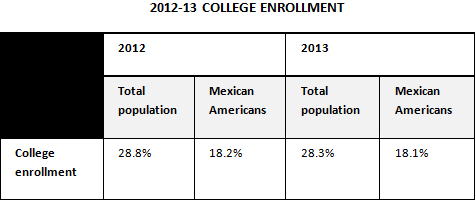
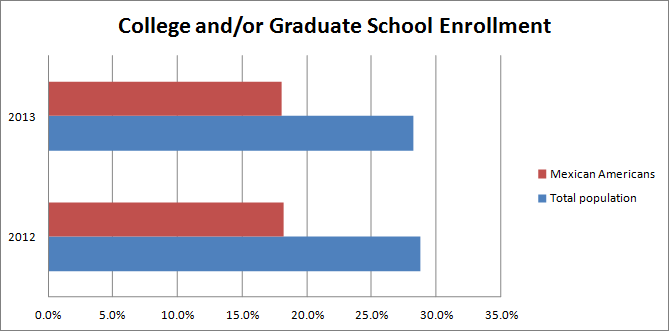
EDUCATIONAL ATTAINMENT
Educational attainment for the general population has risen by .3% from the years 2012 to 2013. For Mexican Americans, it has decreased by .1%
Earned bachelor’s degrees for the general population have risen by .2% and a bit more for Mexican Americans at .3%
Associate degrees and/or some college has shown little change across the board.
Unfortunately, only 2.8% of Mexican Americans and 1.5% of foreign-born Mexican Americans completed a graduate or professional degree in 2013. This is an extremely low percentage because the total population completion of a graduate or professional degree in 2013 was 11.2%. Why are Mexicans and native-born Mexicans not obtaining their graduate degrees? While only 7.3% of Mexican Americans have B.A. degrees, many are settling for associate degrees—21.8% of Mexican Americans and 12.1% of foreign-born Mexican Americans are ending their academic careers upon achieving these two-year degrees, according to the 2013 data.
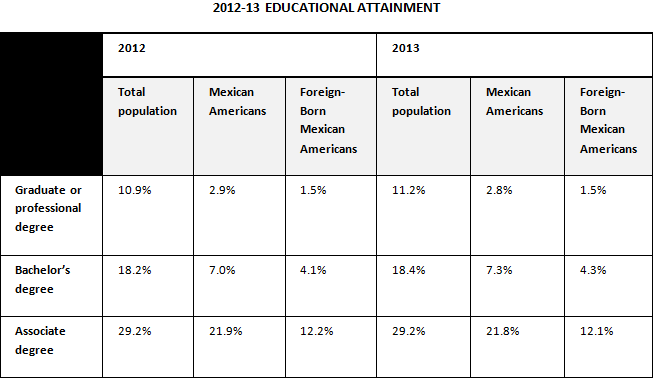
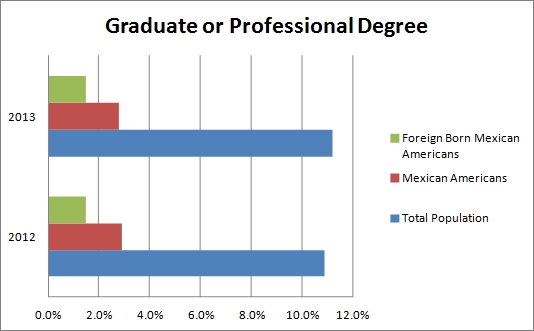
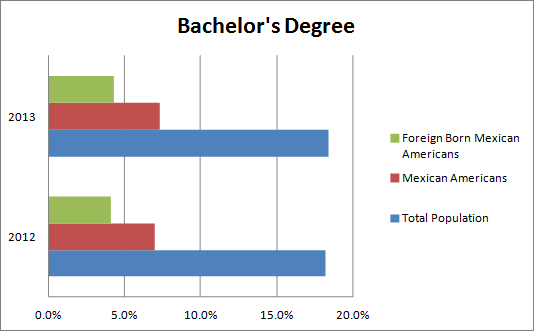
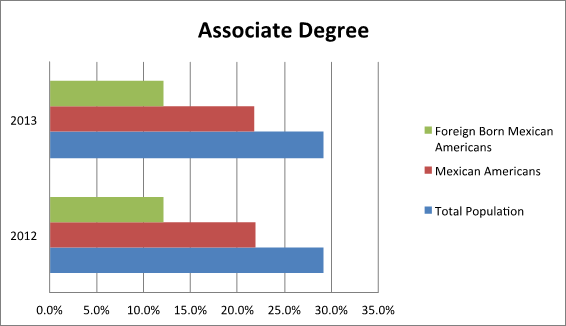
OCCUPATIONS
For the year 2013, the data for civilian employed population 16 years and over in management, business, science, and arts occupations is: 36.3% for the total population, 16.7% for Mexican Americans, and 9.2% for foreign-born Mexican Americans. Again, dismal figures.
Compared to the 2012 results, which were for the total population of 36.1% and for Mexican Americans 16.6%, there was a .2% increase for the total population and .1% for Mexican Americans. There was also a .2% increase for foreign-born Mexican Americans. Not much change, but some hope.
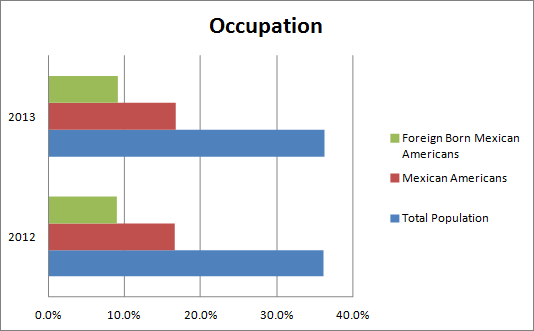
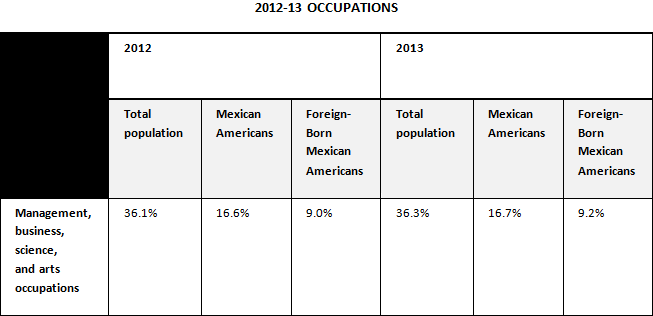
INDUSTRY
For professional, scientific, management and administration, and waste management services, 2013 employment for the total population was 11.1% and 10.2% for Mexican Americans, with foreign-born Mexican Americans at 11.5%. The 2012 results were for the total population 10.9% and 10.2% for Mexican Americans with the foreign-born Mexican Americans at 11.6%. No change for Mexican Americans and a .2% increase for the total population. However, a happy surprise: in 2013, foreign-born Mexican Americans topped all groups at 11.5% with a small decrease from 2012.
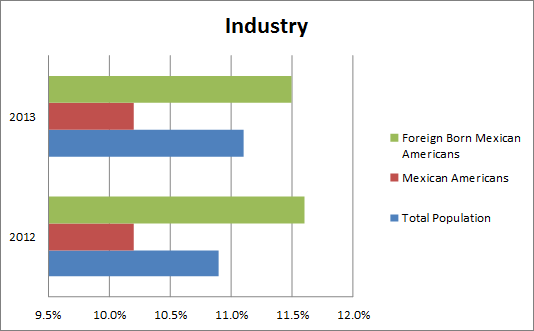
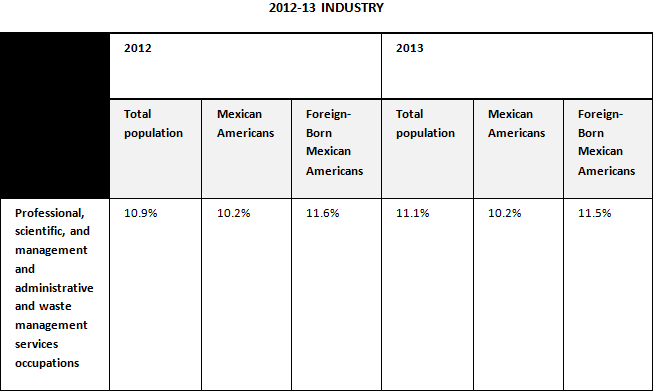
This represents a mixed picture for Mexican Americans and for foreign-born Mexican Americans in their quest for parity with the total population.
Solution for Retaining Minority Students in Higher Education
Scott Watson Swail’s 2003 report (1) on student retention programs in higher education states that a comprehensive student retention program should:
- rely on proven research
- suit the particular needs of the campus
- be institutionalized and become a regular part of campus service
- involve all campus departments and all campus personnel
- take into consideration the dynamics of the change process and provide extensive and appropriate retraining of staff
- be student centered
- operate in a cost-effective way, and not be tied to soft monies
- have the support of a comprehensive student monitoring system that will become the foundation of all institutional research on campus and support every department
- be sensitive to student needs and to diverse populations.
At least some of the above recommendations would go a long way to encourage many minority students to continue their higher education by obtaining a graduate or professional degree.
Berkley, Stanford, UCLA, and Caltech collaborate to boost minority Ph.D. students by recruiting underrepresented students in mathematical, physical and computer sciences, and in engineering.
UC Berkley put it best: “The four schools are creating a unique, cross-institutional community of underrepresented minority Ph.D. students, postdoctoral scholars, and faculty members in the targeted fields; developing faculty training to better recognize and help these students thrive and advance; and conducting research that includes annual surveys of Ph.D. students about what factors impact their attitudes, experiences and preparation for the future.”(2)
References
- Census Bureau, Selected Population Profile in the United States: 2012 and 2013
- United States S0201 and B 05006. Selected population Profile in the United States
- Population groups: Mexican and Mexico (foreign-born)
- Data set: American Community Survey 1-Year Estimates for years 2012 and 2013.
- Census Bureau, American Fact Finder, Selected population Profile in the Untied States.
————————————————–
(1) Watson Scott Swail, Retaining Minority Students in Higher Education: A Framework for Success, George Washington University, 2003
(2) Gretchen Kell, “Berkeley, Stanford, UCLA, Caltech unite to boost number of minority Ph.D. students, faculty,” UC Berkley News Center, February 13, 2014
Majority of of STEM College Graduates Do Not Work in STEM
Jul 10, 2014 – About the Newsroom · Facts for Features · News Releases · Press Kits · Tip Sheets … The U.S. Census Bureau reported today that 74 percent of those who have … however these graduates are not necessarily employed in STEM occupations … The tables released today highlight statistics on field of degree, …
Link to press release
5 influential inventions by Latinos
Some of the things you have used -and some you haven’t- were invented by a Latino and you didn’t even know it.
Link to article


